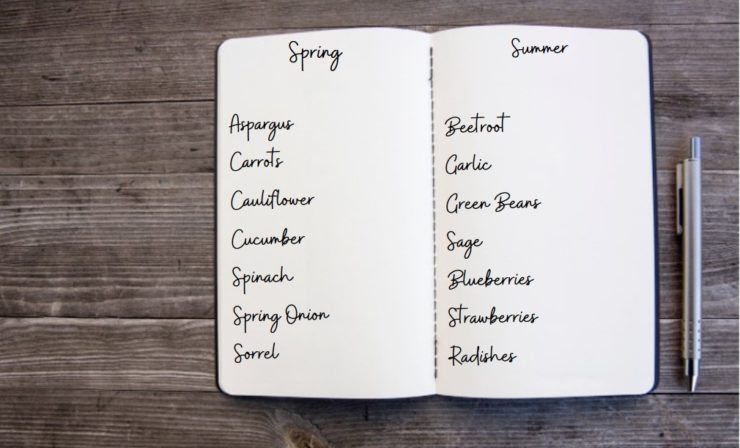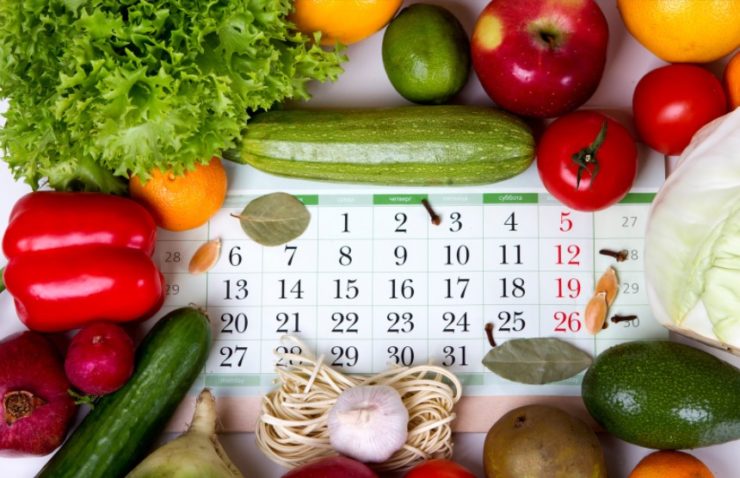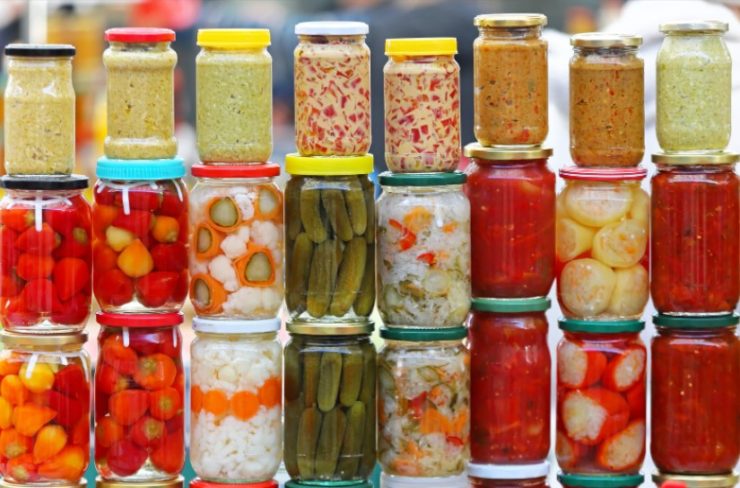Eating seasonally is a great way to get the best and most delicious ingredients throughout the year. It’s also an effective way of exploring and tasting new foods, rather than eating the same old standbys day in and day out.
Building and planning the menu in a restaurant was always one of the most exciting aspects of working in a professional kitchen. And letting the seasons guide the way has always been my favorite approach.
Not only do the ingredients that are in season taste better, but I think we naturally crave them. Fresh, light, and often cold foods in the spring and summer, followed by rich, warm, and comforting dishes in the fall and winter.
Today, I’ll show you how to find the ingredients that grow in your region so you’ll be able to eat food that tastes better and is better for the environment.
In This Article
7 Steps To Seasonal Eating
Eating seasonally all year round is definitely doable, but it can also be challenging depending on where you live. Just remember to stay flexible and don’t be ashamed if you eat a peach in the winter or pineapple in New York.
1. Get To Know Your Seasons

One of the best ways to eat seasonally is to eat locally. Buying and eating food that’s grown or raised close to home is a foolproof way to get ingredients that are at their peak.
We’re incredibly spoiled in the way we can buy any ingredient at any time of year, no matter where we live. But, eating tomatoes in the winter and asparagus in the fall when they are far from in season means they’re going to be expensive. And more importantly, won’t taste very good.
Not to mention they probably traveled hundreds or thousands of miles to get to your plate – which is a whole other topic that we can tackle at another time.
This first step is a quick and easy way to get a broad idea of what seasonal ingredients you can expect for an entire year. Depending on where you live, this could end up being a short and relatively limited list, or one that’s long and full of endless possibilities.
If you live in Colorado (like I do) you’ll have access to a decent range of ingredients but only for limited periods of time due to the short growing seasons. If you live in California on the other hand, you can probably get just about any ingredient you can imagine. And the long growing seasons mean those ingredients are available for more time.
The Seasonal Food Guide is an excellent and easy-to-use resource that will tell you what’s growing in your state at any time of year. But, my favorite method for finding out what will be available in the coming seasons is to talk to a produce farmer in your area.
Not only will they be able to tell you what’s in season, but what, when, and where you can actually buy that produce. Having a relationship with a good farmer is an invaluable resource. Whether you’re a chef in a restaurant or a home cook who simply wants the best ingredients they can get.
2. Make A Food Calendar

Once you have an idea of the seasonal foods in your region, write them down. You could do this broadly by season, or get more detailed and write down what will be harvested every month.
I like to keep a list like this in the kitchen and close to a physical calendar. That way you can quickly reference what ingredients you’ll be able to work with at any point in the year. And that will make the next step a piece of cake.
The good thing is that you really only have to do this once, since regional produce tends to stay about the same each year. After doing this for a while, you’ll know what food is coming down the pipeline without even having to check.
3. Plan Ahead

A little planning will go a long way when it comes to eating seasonally, and it doesn’t need to be complicated.
Getting to know your seasons and what’s available in your area is half the battle when it comes to a solid game plan. From there you can make things as simple or complex as you’d like.
One of the best ways to ensure your success is to do a bit of meal planning. I’ve written a step-by-step guide to get started, but the basic idea is to simply plan all of your meals a week in advance.
Eating seasonally is actually a great way to simplify the whole meal planning process. Just look at the produce that’s being harvested now and in the coming weeks, and base your meals around those ingredients.
Now, don’t feel obligated to only use ingredients that are in season. Just do your best to incorporate them when you can. Tropical fruits and citrus are never in season where I live, but that doesn’t stop me from using avocados and lemons throughout the year. And don’t even get me started on coffee.
4. Visit Your Local Farmers Market

Your local farmers’ market is one of the best places to find and buy seasonal food. But, it can be an even more incredible resource if you’re willing to chat it up with any of the farmers running the stands.
One of my favorite parts about running a professional kitchen was the relationships that were built with the local food purveyors, foragers, and farmers. And I would highly suggest befriending one or two of your own.
They’ll be able to help you choose the best products of the moment. Plus, they can let you know what’s going to be harvested next and if there’s an especially good crop of this or that, as well as how best to use each ingredient.
Even if you haven’t built up the courage to chit-chat with the growers, the farmers market is still one of your best bets to find food that’s in season.
If you don’t have one in your area, you’re not completely out of luck. Even most mega grocery stores will stock local and seasonal products, and will often point that out with signs and stickers.
5. Preserve And Store Food For The Winter

Eating seasonally is easier and often more exciting in the spring and summer months. There’s always a wide variety of items available, and new fruits and vegetables are constantly sprouting, being harvested, and showing up in your local stores.
The late fall and winter on the other hand can be a different story, one with much less variety. But, if you plan ahead and get creative, there’s no reason those cold months can’t be just as exciting and delicious as the rest of the year.
There’s nothing I love more than rich and comforting stews and braises that rely heavily on fall root vegetables. But, the flavors of spring and summer can add some much-needed brightness to dreary January.
Pickling, canning, drying, and freezing are all great ways to make seasonal items available at any time of the year. So, when produce is abundant (and less expensive) in the late summer and early fall, buy a little extra and experiment with preservation.
Then, when February rolls around and you can’t stomach another butternut squash or brussels sprout. You’ll have some exciting flavors to get you through to spring.
6. Join A CSA Program

If you’re lucky enough to have one in your area, join a CSA (community-supported agriculture program). These are programs that basically bring the farmer’s market to you.
You pay a monthly subscription fee and you get a box of produce, and sometimes meat and eggs delivered to your door.
This is a great way to get fresh and seasonal ingredients, without even having to leave the house. Now, you generally don’t have a say in what comes in each box. But, if you’ve done your homework in step 1, you should have a good idea of what to expect depending on the season.
Plus, it can be pretty exciting getting a mystery box full of ingredients that were grown close to home.
7. Grow Your Own Food

This is a step to seasonal eating that’s a bit more involved, but it can also be the most rewarding.
It can be incredibly intimidating to start your own food garden, and that’s why I think it’s a good idea to start small. It can be a single pot with one herb in it or a small garden box with tomato and squash.
Regardless of how big or small your garden is, if there’s food growing, you’ll have no question whether it’s in season or not. You probably won’t be growing 100% of your own food, but this is a great way to supplement your grocery shopping and help guide you through the seasons.
Keep It Simple
Remember to start small. Trying out all of the tips and tricks above can take time, so don’t feel overwhelmed by starting from scratch and attempting them all at once.
Eating seasonally is a simple idea, and while it takes some thought and effort, it gets much easier the more you do it. Look for incremental gains.
Just remember that a little bit of research upfront will tell you all of the seasonal foods you can expect throughout the year. After that, a little planning and flexibility are all it takes to get the best, most delicious ingredients every season.
Meal planning is a great way to incorporate seasonal eating into your daily life. So be sure to check out our beginner’s guide to meal planning to get started on the right foot.







